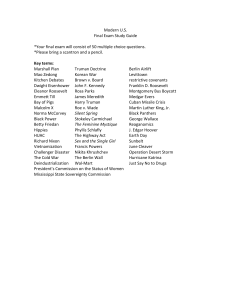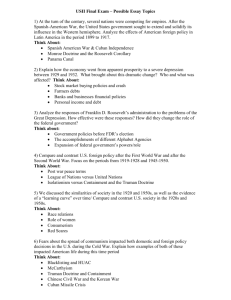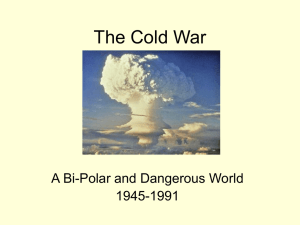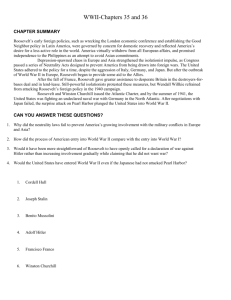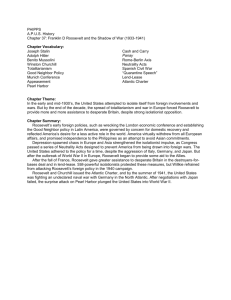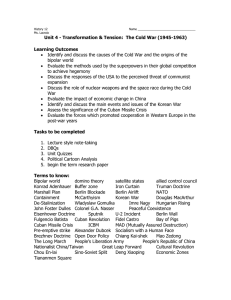Unit 4: Establishment as a World Power
advertisement
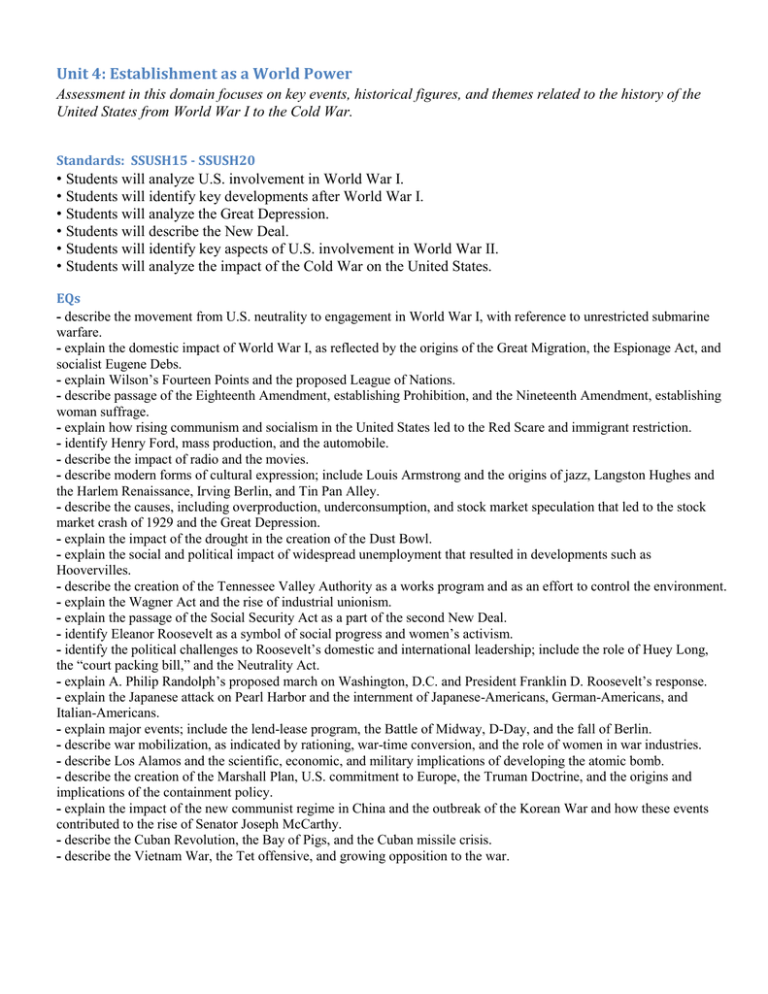
Unit 4: Establishment as a World Power Assessment in this domain focuses on key events, historical figures, and themes related to the history of the United States from World War I to the Cold War. Standards: SSUSH15 - SSUSH20 • Students will analyze U.S. involvement in World War I. • Students will identify key developments after World War I. • Students will analyze the Great Depression. • Students will describe the New Deal. • Students will identify key aspects of U.S. involvement in World War II. • Students will analyze the impact of the Cold War on the United States. EQs - describe the movement from U.S. neutrality to engagement in World War I, with reference to unrestricted submarine warfare. - explain the domestic impact of World War I, as reflected by the origins of the Great Migration, the Espionage Act, and socialist Eugene Debs. - explain Wilson’s Fourteen Points and the proposed League of Nations. - describe passage of the Eighteenth Amendment, establishing Prohibition, and the Nineteenth Amendment, establishing woman suffrage. - explain how rising communism and socialism in the United States led to the Red Scare and immigrant restriction. - identify Henry Ford, mass production, and the automobile. - describe the impact of radio and the movies. - describe modern forms of cultural expression; include Louis Armstrong and the origins of jazz, Langston Hughes and the Harlem Renaissance, Irving Berlin, and Tin Pan Alley. - describe the causes, including overproduction, underconsumption, and stock market speculation that led to the stock market crash of 1929 and the Great Depression. - explain the impact of the drought in the creation of the Dust Bowl. - explain the social and political impact of widespread unemployment that resulted in developments such as Hoovervilles. - describe the creation of the Tennessee Valley Authority as a works program and as an effort to control the environment. - explain the Wagner Act and the rise of industrial unionism. - explain the passage of the Social Security Act as a part of the second New Deal. - identify Eleanor Roosevelt as a symbol of social progress and women’s activism. - identify the political challenges to Roosevelt’s domestic and international leadership; include the role of Huey Long, the “court packing bill,” and the Neutrality Act. - explain A. Philip Randolph’s proposed march on Washington, D.C. and President Franklin D. Roosevelt’s response. - explain the Japanese attack on Pearl Harbor and the internment of Japanese-Americans, German-Americans, and Italian-Americans. - explain major events; include the lend-lease program, the Battle of Midway, D-Day, and the fall of Berlin. - describe war mobilization, as indicated by rationing, war-time conversion, and the role of women in war industries. - describe Los Alamos and the scientific, economic, and military implications of developing the atomic bomb. - describe the creation of the Marshall Plan, U.S. commitment to Europe, the Truman Doctrine, and the origins and implications of the containment policy. - explain the impact of the new communist regime in China and the outbreak of the Korean War and how these events contributed to the rise of Senator Joseph McCarthy. - describe the Cuban Revolution, the Bay of Pigs, and the Cuban missile crisis. - describe the Vietnam War, the Tet offensive, and growing opposition to the war. Key Terms WWI through Harlem Renaissance 1. Unrestricted Submarine Warfare 2. Zimmerman Note 3. Selective Service Act 4. Great Migration 5. Espionage Act 6. Liberty Bonds 7. Fourteen Points 8. League of Nations 9. Communism 10. Red Scare 11. Palmer Raids 12. Mass Production 13. Harlem Renaissance 14. Tin Pan Alley Great Depression + New Deal 15. Speculation 16. Buying on Margin 17. Black Tuesday 18. The Great Depression 19. Hoovervilles 20. Dust Bowl 21. Twenty-First Amendment 22. 23. 24. 25. 26. 27. 28. 29. 30. WWII 31. 32. 33. 34. 35. 36. 37. 38. 39. 40. 41. 42. 43. 44. Key People 1) President Woodrow Wilson 2) President Herbert Hoover 3) President Franklin Delano Roosevelt 4) President Harry S. Truman 5) President Dwight Eisenhower 6) Louis Armstrong 7) Langston Hughes 8) Irving Berlin 9) Adolf Hitler 10) Joseph Stalin 11) Douglas MacArthur 12) Eleanor Roosevelt 13) Eugene Debbs 14) Huey Long 15) Father Coughlin 16) A. Phillip Randolph 17) Joseph McCarthy 18) Fidel Castro Hawley-Smoot Tariff Bonus Army Hundred Days New Deal Tennessee Valley Authority Wagner Act Social Security System Deficit spending “court packing” (783) Neutrality Act Lend-Lease Act Atlantic Charter Pearl Harbor Bataan Death March Battle of Midway Island Hopping D-Day Battle of the Bulge Internment Camps V-E Day V-J Day The Manhattan Project Los Alamos 45. Atomic Bomb Cold War 46. United Nations 47. Yalta Conference 48. Potsdam Conference 49. Iron Curtain 50. Cold War 51. Containment 52. Truman Doctrine 53. Marshall Plan 54. Berlin Airlift 55. NATO 56. HUAC 57. McCarthyism 58. Korean War 59. Brinksmanship 60. ICBMs 61. Sputnik 62. Cuban Revolution 63. Bay of Pigs 64. Cuban Missile Crisis 65. Vietnam War 66. Gulf of Tonkin Resolution 67. Tet Offensive
